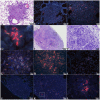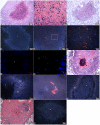Location of intra- and extracellular M. tuberculosis populations in lungs of mice and guinea pigs during disease progression and after drug treatment
- PMID: 21445321
- PMCID: PMC3061964
- DOI: 10.1371/journal.pone.0017550
Location of intra- and extracellular M. tuberculosis populations in lungs of mice and guinea pigs during disease progression and after drug treatment
Abstract
The lengthy treatment regimen for tuberculosis is necessary to eradicate a small sub-population of M. tuberculosis that persists in certain host locations under drug pressure. Limited information is available on persisting bacilli and their location within the lung during disease progression and after drug treatment. Here we provide a comprehensive histopathological and microscopic evaluation to elucidate the location of bacterial populations in animal models for TB drug development.To detect bacilli in tissues, a new combination staining method was optimized using auramine O and rhodamine B for staining acid-fast bacilli, hematoxylin QS for staining tissue and DAPI for staining nuclei. Bacillary location was studied in three animal models used in-house for TB drug evaluations: C57BL/6 mice, immunocompromised GKO mice and guinea pigs. In both mouse models, the bacilli were found primarily intracellularly in inflammatory lesions at most stages of disease, except for late stage GKO mice, which showed significant necrosis and extracellular bacilli after 25 days of infection. This is also the time when hypoxia was initially visualized in GKO mice by 2-piminidazole. In guinea pigs, the majority of bacteria in lungs are extracellular organisms in necrotic lesions and only few, if any, were ever visualized in inflammatory lesions. Following drug treatment in mice a homogenous bacillary reduction across lung granulomas was observed, whereas in guinea pigs the remaining extracellular bacilli persisted in lesions with residual necrosis. In summary, differences in pathogenesis between animal models infected with M. tuberculosis result in various granulomatous lesion types, which affect the location, environment and state of bacilli. The majority of M. tuberculosis bacilli in an advanced disease state were found to be extracellular in necrotic lesions with an acellular rim of residual necrosis. Drug development should be designed to target this bacillary population and should evaluate drug regimens in the appropriate animal models.
Conflict of interest statement
Figures





References
-
- WHO annual report on global TB control–summary. Wkly Epidemiol Rec. 2003;78:122–128. - PubMed
-
- Trends in tuberculosis–United States, 2007. MMWR Morb Mortal Wkly Rep. 2008;57:281–285. - PubMed
-
- Gomez JE, McKinney JD. M. tuberculosis persistence, latency, and drug tolerance. Tuberculosis (Edinb) 2004;84:29–44. - PubMed
-
- Sacchettini JC, Rubin EJ, Freundlich JS. Drugs versus bugs: in pursuit of the persistent predator Mycobacterium tuberculosis. Nat Rev Microbiol. 2008;6:41–52. - PubMed
-
- Ehlers S. Lazy, dynamic or minimally recrudescent? On the elusive nature and location of the mycobacterium responsible for latent tuberculosis. Infection. 2009;37:87–95. - PubMed
Publication types
MeSH terms
Substances
Grants and funding
LinkOut - more resources
Full Text Sources
Other Literature Sources
Molecular Biology Databases

